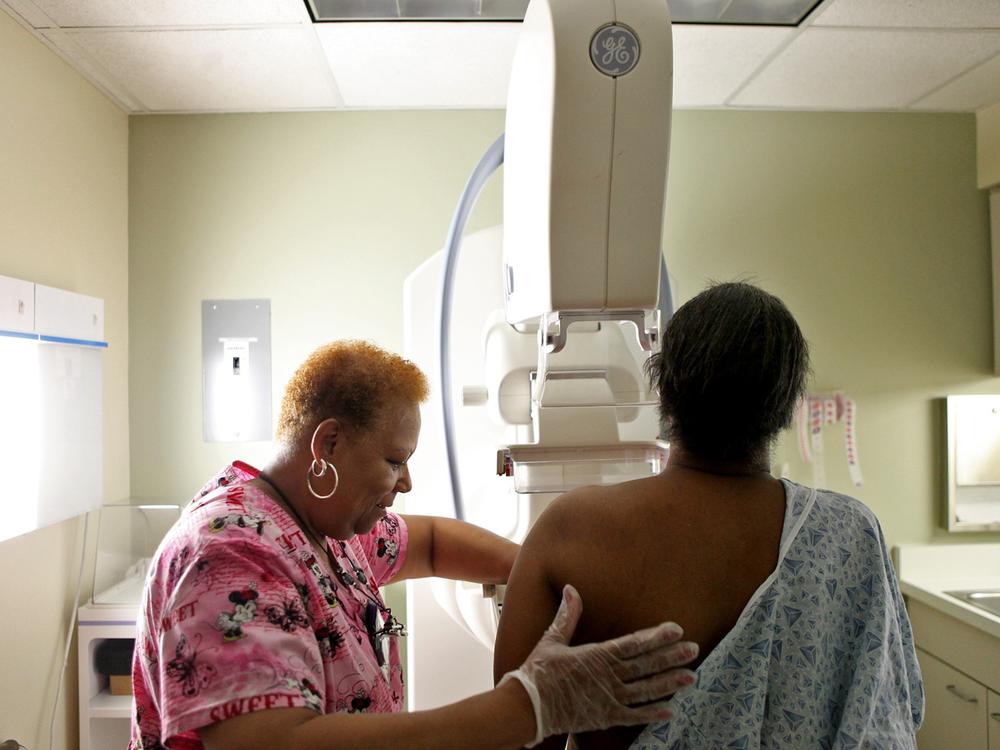Section Branding
Header Content
Mammograms have pros and cons. Women can handle the nuance, study argues
Primary Content
New research makes the case for educating women in their 40s — who've been caught in the crossfire of a decades-long debate about whether to be screened for breast cancer with mammograms — about the harms as well as the benefits of the exam.
After a nationally representative sample of U.S. women between the ages of 39 and 49 learned about the pros and cons of mammography, more than twice as many elected to wait until they turn 50 to get screened, a study released Monday in the Annals of Internal Medicine found.
Most women have absorbed the widely broadcast message that screening mammography saves lives by the time they enter middle age. But many remain unaware of the costs of routine screening in their 40s — in false-positive results, unnecessary biopsies, anxiety and debilitating treatment for tumors that left alone would do no harm.
"In an ideal world, all women would get this information and then get to have their further questions answered by their doctor and come up with a screening plan that is right for them given their preferences, their values and their risk level," said social psychologist Laura Scherer, the study's lead author and an associate professor of research at the University of Colorado School of Medicine.
Of 495 women surveyed, only 8% initially said they wanted to wait until they turned 50 to get a mammogram. After researchers informed the women of the benefits and the harms, 18% said they would wait until 50.
"We're not being honest"
Learning about the downsides of mammograms did not discourage women from wanting to get the test at some point, the study showed.
The benefits and the harms of mammography came as a surprise to nearly half the study's participants. More than one-quarter said what they learned from the study about overdiagnosis differed from what their doctors told them.
"We're not being honest with people," said breast cancer surgeon Laura Esserman, director of the University of California San Francisco Breast Care Center, who was not involved with the research.
"I think most people are completely unaware of the risks associated with screening because we've had 30, 40 years of a public health messaging campaign: Go out and get your mammogram, and everything will be fine," she said in an NPR interview.
Esserman sees women who are diagnosed with slow-growing tumors that she believes in all likelihood would never harm them. In addition, mammography can give women a false sense of security, she said, like it did for Olivia Munn.
The 44-year-old actress had a clean mammogram and a negative test for cancer genes shortly before her doctor calculated her score for lifetime breast cancer risk, setting off an alarm that led to her being treated for fast-moving, aggressive breast cancer in both breasts.
Toward a personalized plan for screening
Esserman advocates for a personalized approach to breast cancer screening like the one that led to Munn's diagnosis. In 2016, she launched the WISDOM study, which aims to tailor screening to a woman's risk and, in her words, "to test smarter, not test more."
The National Cancer Institute estimates that more than 300,000 women will be diagnosed with breast cancer and 42,250 will die in the U.S. this year. Incidence rates have been creeping up about 1% a year, while death rates have been falling a little more than 1% a year.
For the past 28 years, the influential U.S. Preventive Services Task Force has been flip-flopping in its recommendations about when women should begin mammography screening.
From 1996 until 2002, the independent panel of volunteer medical experts who help guide physicians, insurers and policymakers said women should begin screening at 50. In 2002, the task force said women in their 40s should be screened every year or two. In 2009, it said that 40-something women should decide whether to get mammograms based on their health history and individual preferences.
The new study was conducted in 2022, when the task force guidelines called for women in their 40s to make individual decisions.
New guidelines
In 2024, the panel returned to saying that all women between the ages of 40 and 74 should be screened with mammograms every other year. Rising breast cancer rates in younger women, as well as models showing the number of lives that screening might save, especially among Black women, drove the push for earlier screening.
An editorial accompanying the new study stresses the need for education about mammography and the value of shared decision-making between clinicians and patients.
"For an informed decision to be made," states the editorial written by Dr. Victoria Mintsopoulos and Dr. Michelle B. Nadler, both of the University of Toronto in Ontario, "the harms of overdiagnosis — defined as diagnosis of asymptomatic cancer that would not harm the patient in the future — must be communicated."

